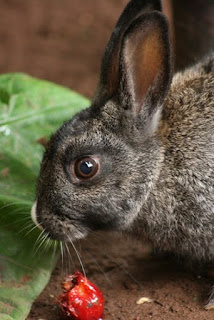Although rabbits and hares belong to the same family and look so much alike that they are mistaken for each other, there is a difference between them.
The easiest time to notice this difference is at birth. Rabbits are born blind, without fur, and cannot move about. Their eyes open in about a week, and when they are two weeks old, they are able to leave their nest.
Newborn hares, however, are born with their eyes open. They have a full coat of fine, soft fur, and can hop about within a few hours after their birth.
As both animals grow, hares become larger than rabbits, and have longer hind legs and bigger ears.
Rabbits, when frightened by enemies, can leap 10 feet or more and run as fast as 18 miles an hour!
Rabbits burrow their homes into the ground while hares make theirs on top of it.
 This rabbit has a varied diet. It follows me home so I can give it bread plus it eats all the fallen fruit and leaves in the graden. :)
This rabbit has a varied diet. It follows me home so I can give it bread plus it eats all the fallen fruit and leaves in the graden. :)















